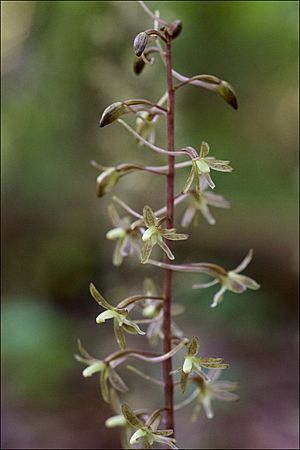Crippled cranefly facts for kids
Quick facts for kids Crippled cranefly |
|
|---|---|
 |
|
| Scientific classification | |
| Genus: |
Tipularia
|
| Species: |
discolor
|
The Crane-fly orchid (Tipularia discolor) is a special kind of orchid that grows in woodlands. It's also known as the crippled cranefly. This plant is the only type of Tipularia orchid found in North America. It belongs to the large Orchidaceae family, which includes many beautiful flowering plants.
Contents
Where the Crane-Fly Orchid Lives
This unique orchid grows in the southeastern United States. You can find it from Texas all the way to Florida. Its home also stretches north into the Ohio Valley and along the Appalachian Mountains. It can be seen as far north as the Catskill Mountains. There are also a few smaller groups of these orchids in Massachusetts and near the Great Lakes region.
The Orchid's Unique Life Cycle
The Crane-fly orchid has a very interesting way of growing. It produces a single leaf in September, which is in the fall. This leaf stays on the plant through the winter. Then, in the spring, the leaf disappears.
The top of the leaf is green. It often has dark purple spots, which makes it look quite pretty. But the most striking part is the underside of the leaf, which is a bright purple color!
The flowers of the Crane-fly orchid bloom later in the year. You can see them from mid-July to late August.
What Are Its Roots Like?
The roots of this orchid are a series of connected parts called corms. These corms are edible, meaning you can eat them. They are starchy, a bit like small potatoes.
How It Gets Pollinated
The Crane-fly orchid relies on noctuid moths to help it make seeds. These moths are often active at night. The orchid's flowers are designed in a clever way to attract them.
Each flower tilts slightly to the right or left. This special tilt helps the orchid's pollen, called pollinaria, attach to one of the moth's compound eyes. When the moth flies to another orchid, it carries the pollen with it, helping the plants reproduce.
Protecting This Orchid
Sadly, Crane-fly orchids are not as common as they used to be. In several states, they are considered endangered, threatened, or rare. This means they need special protection to make sure they continue to grow in our woodlands.
Images for kids







